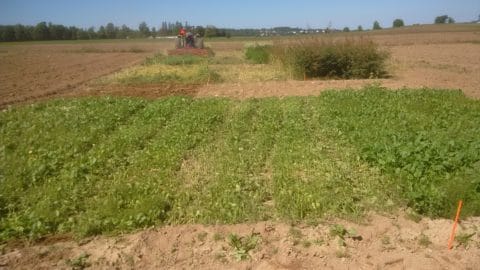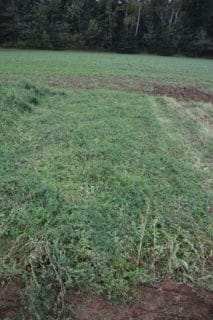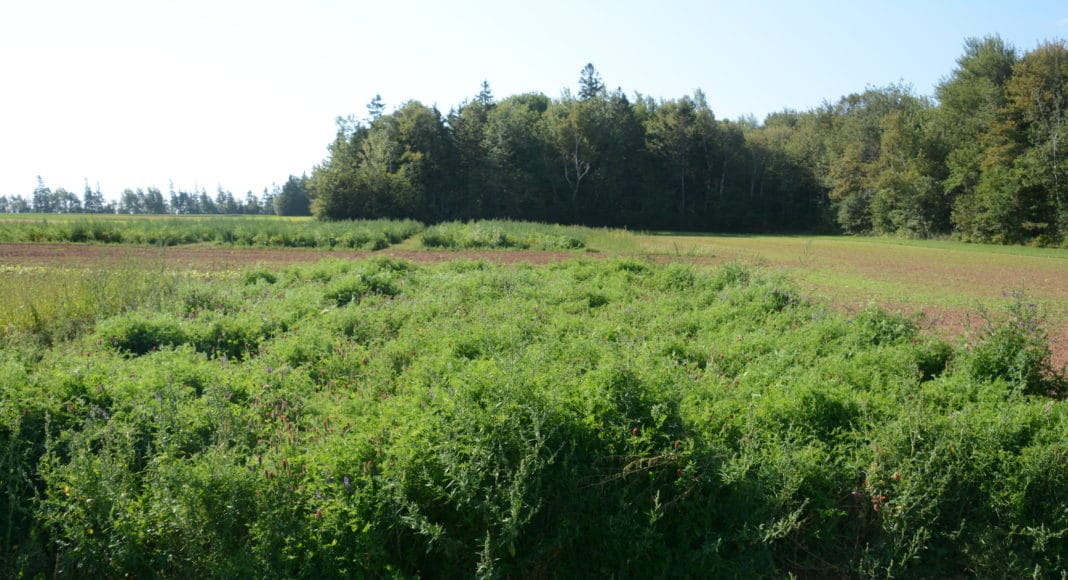[deck]Cover crops like brown mustard and buckwheat are already being used to control wireworms by some potato producers in Canada — but will they also work to kill problem weeds? Researchers working on an Agriculture and Agri-Food Canada weed control project are trying to find out.[/deck]
IN ATLANTIC CANADA, Agriculture and Agri-Food Canada researchers are tackling the thorny problem of herbicide resistance in potatoes by looking into the biofumigant effects of different cover crops on weeds and weed seeds.
The research is part of a broader integrated weed management plan for potatoes that’s being developed to counter the impact of rising herbicide resistance as well as the potential loss of linuron, a major weed control product and resistance management tool in potatoes under review by Health Canada’s Pest Management Regulatory Agency.
Andrew McKenzie-Gopsill, an AAFC weed scientist based at the Charlottetown Research and Development Centre in Prince Edward Island who is leading the initiative, says the cover crop study is focusing on lamb’s quarters, a triazine-resistant weed that’s a common sight in farmers’ fields across Canada.
According to McKenzie-Gopsill, the project is somewhat unique in that it utilizes a seed bank-targeted approach to weed management.

“Lamb’s quarters is a prolific seed producer,” McKenzie-Gopsill says. “We’re trying to see if we can suppress it with our cover crops as well as to see if there’s any effect on that weed seed bank with these cover crops and then various termination methods on top of that.”
The researchers are analyzing the biofumigant effects of these four different cover crops: brown mustard, buckwheat, timothy, a mix of hairy vetch, crimson clover and annual rye.
McKenzie-Gopsill says brown mustard and buckwheat were chosen for study because they’re already being used in Prince Edward Island as rotation crops for wireworm control.
“When wireworms eat the roots or the decaying plant matter of brown mustard and buckwheat, it gets converted, from what I understand, into cyanide in their gut and kills them,” he says.
“More and more growers are incorporating them into their rotations, so we’re trying to see if there’s an additional effect on the weed seed bank.”
McKenzie-Gopsill notes some research has been conducted into the use of brown mustard as a biofumigant against weed seeds. He adds buckwheat is known as a good weed suppressor but it’s unclear whether it has a biofumigant effect on the weed seed bank.
Timothy was included because it’s often grown in a potato rotation as a forage crop, while the hairy vetch, crimson clover and annual rye mix is something that’s being incorporated more and more into AAFC studies, McKenzie-Gopsill says.

PHOTO: AAFC
The three-year research project, which wraps up this year, is being conducted at the AAFC’s Research and Development Centres in Prince Edward Island and New Brunswick and involves numerous collaborators in both provinces.
McKenzie-Gopsill says the study started with research plots being planted with the cover crops in 2018 and then planted with potatoes in 2019 to measure the effects of each cover crop on the weed seed bank. The process is being repeated on another set of research plots where potatoes will be planted this year.
McKenzie-Gopsill says the research data continues to be assessed and that a full report on the study will be released in 2021. He did offer up a few general observations from the first year of the study, however.
The hairy vetch, crimson clover and annual rye mix, for example, appeared to be quite effective as a weed suppressor.
“From what I’m seeing and some of the data we’re collecting, it produces a ton of biomass and really kind of chokes everything else out,” says McKenzie-Gopsill.
He notes there was also a reduction in weed pressure with buckwheat, while timothy was less effective at suppressing weeds than the other cover crops.

plot containing a mix of hairy vetch, crimson clover and annual rye after the cover crop
was terminated with a roller crimper.
PHOTO: AAFC
“We had a pretty hard time getting the timothy to establish,” McKenzie-Gopsill says. “The field that had timothy really looked more like a field of lamb’s quarters than anything else.”
IMPORTANCE OF MULCH
Another important aspect of the study is how different methods for terminating cover crops will affect the weed seed bank.
The researchers are measuring the amount of biomass or mulch that’s left once each cover crop is terminated by the following four means:
• applying glyphosate
• mowing
• mowing and disking
• using a roller crimper
When there’s lots of mulch left over in the field, this creates a favourable environment for weed seed predators such as soil-dwelling invertebrates, small mammals and birds, McKenzie-Gopsill notes. If conditions are right, he says, up to 40 per cent of a field’s weed seeds can be eliminated in this way.
McKenzie-Gopsill says clear differences in the amount of biomass produced by each termination method have been observed — and the roller crimper treatment in particular resulted in a “fantastic layer of mulch.”
Laura Anderson is a graduate student at Dalhousie University in Halifax, N.S., who is overseeing the field work in the cover crop study. She contends, in the face of rising herbicide resistance, a multi-faceted approach to weed control that includes options like biofumigant cover crops could be very beneficial for the potato industry.
“Growers have become reliant on their herbicide options, but I think as resistance becomes more and more of an issue in their operations, they’re looking for other strategies,” she says.
Anderson believes as the herbicide toolbox becomes more limited, the idea of using cover crops to control problem weeds is something growers could really get behind.
“Especially here [in Atlantic Canada], potato farmers are becoming more familiar with biofumigation and have been using brown mustard for wireworm control,” she says.
McKenzie-Gopsill says researchers are also examining a number of other weed management options which could eventually be part of a larger integrated weed management plan for potato producers. These include crop rotations, inter-row cultivation and a novel technique known as flame weeding.
The flame weeding research involves using a handheld propane torch to burn out weeds in small potato plots, McKenzie-Gopsill notes.
“It is viable in that kind of situation,” he says. “I’ve never spoken to anybody who’s tried flame weeding on a large-scale potato production, but it is a possibility.”











